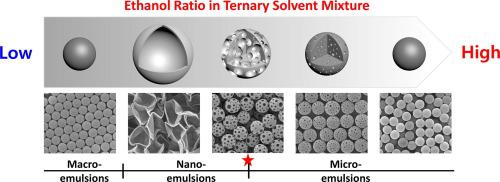Chemical Engineering Journal ( IF 13.3 ) Pub Date : 2020-11-05 , DOI: 10.1016/j.cej.2020.127628 Dae Hwan Kim , Jae Hwan Jeong , Hee-Chul Woo , Mun Ho Kim

|
Porous polymer microspheres with interconnective open pores have attracted significant interest, owing to their unique properties as compared to those of traditional microspheres. However, developing a facile synthetic method to produce these unique particles remains a challenge. Herein, a method is proposed to produce highly porous polystyrene (PS) microspheres with interconnective open pores and a uniform size distribution, which were prepared by simply dispersing PS seed particles in an oil-in-water emulsion system. The morphological evolutions of the PS microspheres exposed to different types of oil-in-water emulsions were systematically investigated, and the relationship between the colloidal stability of the emulsions and the final structure of the PS microspheres was studied. Based on these results, the best oil-in-water system for synthesizing highly porous PS microspheres with interconnected open pores was found. The proposed synthetic method was demonstrated to offer significant advantages over previously developed techniques; it was simple, fast, and easy to process, and did not require special additives such as surfactants, complex techniques, etching processes to generate pores, and sophisticated equipment. Catalytic microreactors were fabricated by synthesizing mono- and bimetallic nanocrystals on the surface of the porous microspheres via in situ chemical reduction. When the microreactors were used as a heterogenous catalyst for the 4-nitrophenol (4-NP) reduction reaction by sodium borohydride (NaBH4), they exhibited extremely high catalytic activity and excellent recyclability. These results demonstrated that the highly porous microspheres have very high porosity, huge surface area per unit volume, and good chemical stability, indicating their great potentials as a supporting material for practical applications in catalysis.
中文翻译:

具有互连的开孔的高孔隙率聚合物微球的催化微反应器的合成
具有连通的开孔的多孔聚合物微球由于与传统微球相比具有独特的性能而引起了人们的极大兴趣。然而,开发一种容易的合成方法来生产这些独特的颗粒仍然是一个挑战。在此,提出了一种通过将PS种子粒子简单地分散在水包油型乳剂体系中而制备的具有相互连通的开孔且尺寸分布均匀的高多孔性聚苯乙烯(PS)微球的方法。系统地研究了暴露于不同类型水包油乳液中的PS微球的形态演变,研究了乳液的胶体稳定性与PS微球最终结构之间的关系。根据这些结果,发现了用于合成具有相互连接的开孔的高度多孔PS微球的最佳水包油系统。事实证明,所提出的合成方法比以前开发的技术具有明显的优势。它简单,快速且易于加工,并且不需要特殊的添加剂,例如表面活性剂,复杂的技术,产生孔的蚀刻工艺以及复杂的设备。通过在多孔微球表面合成单金属和双金属纳米晶体,制备了催化微反应器。复杂的技术,产生孔的蚀刻工艺以及复杂的设备。通过在多孔微球表面合成单金属和双金属纳米晶体,制备了催化微反应器。复杂的技术,产生孔的蚀刻工艺以及复杂的设备。通过在多孔微球表面合成单金属和双金属纳米晶体,制备了催化微反应器。原位化学还原。当微反应器用作通过硼氢化钠(NaBH 4)进行4-硝基苯酚(4-NP)还原反应的多相催化剂时,它们表现出极高的催化活性和出色的可回收性。这些结果表明,高度多孔的微球具有很高的孔隙率,每单位体积的大表面积和良好的化学稳定性,表明它们具有巨大的潜力,可作为催化实际应用中的支撑材料。





















































 京公网安备 11010802027423号
京公网安备 11010802027423号